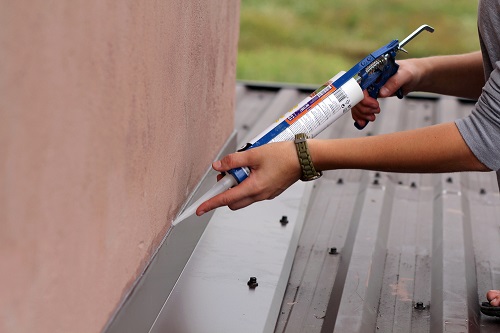
Your home’s roofing system endures the harshest weather conditions imaginable, safeguarding your family from extreme temperatures and helping to maintain a safe environment. The constant wear-and-tear of rain, wind, and snow can take its toll which is why it’s crucial to protect with a reliable sealant – but how? Learn more about what they are and their advantages below!
What is a roof sealant?
Roof sealants help to create a robust shield that defends homes from the elements. Acting as an adhesive coating, these materials provide protection for roof structures by sealing cracks and fixing damaged areas found in roof shingles and flashing. Roof sealants also assist with preventing leaks before they become issues or aid new roofs during the installation process of rolled rubber material layers. They are essential components when it comes to maintaining home integrity against harsh weather conditions while keeping up its aesthetic appeal!
Buying roof sealant
For roof repairs, it’s important to have the right type of sealant on hand. Liquid buckets are great for larger patches and adhering rubber membranes. Caulks make applying beads easy when installing flashing or making small roof repairs. Tapes help patch up smaller areas like shingle tears or flat roofs quickly while spray coatings can cover plywood exposed from damage–though these generally require further sealing in order to be fully effective.
Solvent-based versus water-based sealant
Choosing the right roof sealant will depend on a variety of factors, including budget and desired longevity. Water-based options are inexpensive, and easy to apply due to their spreadable consistency – reducing headaches as they emit fewer odors than solvent-based products. Although more durable in weather conditions, using solvent-based sealants comes with an increased risk of hazardous VOCs being emitted into the air.
Types of roof sealant
Protecting your roof is key, and there are several types of sealants available depending on what material they’re made from. Each option has its unique benefits as well as drawbacks – so choose the right one to keep your structure secure!
Rubber roof sealants are a cost-effective and accessible solution for small repair jobs that require protection against rain or UV rays. While silicone sealants provide greater long-term effectiveness, they can be too costly to justify on larger projects.
Sealant tapes offer an easy solution for repairing leak-prone seams, tears, and rips in rubber membranes or shingles. They are popular among RV owners as they can be applied quickly to address emergency repairs. For regions that experience heavy snowfall and rainfall, polyurethane sealants act as a waterproof barrier protecting the area from moisture passing through small problem areas. However, this type of sealant is not recommended for sunny climates due to its lack of resistance against ultraviolet rays breaking it down over time.
Acrylic sealants are the ideal choice for areas prone to intense UV rays. Rather than absorbing damaging levels of ultraviolet radiation, these materials deflect and disperse them – providing an all-important protective barrier. Although they don’t offer the same waterproofing benefits as polyurethane options, acrylics remain a great option in hot and dry climates due to their remarkable sunshield properties
How can sealants help your roofing system?
Before opting for a roof sealant, homeowners should ensure that it is waterproof. Different types of roofs may be more exposed to water than others; flat roofs often trap rainfall especially in heavy downpours or if their drains become clogged. To provide superior protection against moisture intrusion and potential damage, rubber, polyurethane or silicone-based sealants are the optimal choice.
Knowing the impact of sunlight on roofing sealants can help homeowners make better informed decisions about their home renovations. While polyurethane seals tend to break down in direct contact with UV rays, acrylics offer a more resilient alternative that not only resists but reflects light as well. For long-lasting protection against sun damage, applying multiple coats of sealing product is recommended and will extend its lifetime typically between 10 to 20 years – when replacing an entire roof may be unavoidable anyway!
Those wanting to apply their own roof sealant should take into account the effort required in its application. Water-based rubber or acrylic sealants and sealing tape are simple to use but have relatively short lifespans compared to more complex materials like silicone or polyurethane. It is essential that you research a product’s International Organization for Standardization (ISO) certification level before finding the right solution – these ratings indicate how well each type of material stands up against environmental conditions over time.
Call KM Roof and Home Repair now if you need help fixing your roofing system.
Like our Facebook page for more great info about roofing services.
KM Roof and Home Repair
310 Iveydale Dr.
Greenville, SC 29609
864-535-9184
www.kmroofers.com

No comments:
Post a Comment